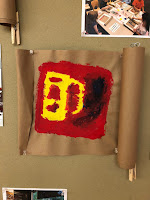What is a number?
In kindergarten, I often see an immediate divide when it comes to "doing" math. Some learners are eager calculators and are thrilled to talk about, look at, and figure out math wonders. Many others, often our girls, appear to lose interest quickly. I often hear the refrain, "I'm not good at math." How does that identity form at such an early point in an educational journey?!
I try to teach with a sensitivity to this feeling among my learners, especially for the girls in my class. I am mindful of studies that illustrate that many girls don't "show up" for maths and sciences. ("Math for Girls, Math for Boys" A.K. Whitney, The Atlantic, 2016)
I am also inspired by many "math shepherds" like Jo Boaler...
In order to build a strong math foundation, we spend a week looking carefully at each number from 0 through 10. We then move one to the pre-teens as a group and the teens as a group. We try to use this number study to find ways to draw in our "I am not good at math" learners.
We look at the week's number carefully in practical ways:
How is it written and how many is it? We also spend some time looking again, with a mathematician’s eye. We ask: When is that number big? When is it small? What might make that number seem to mean a lot? When might it not seem to be so much? Can we double it? Can we divide it?


This week we launched our number study with the number one:
We added a visual artist’s perspective to our number study. We asked, “What might one look like?” Then we painted that on the first section of a long Kraft paper scroll – our math murals – using primary colors.
“I have to paint a big, giant one with little ones all around it.” “Look at that! I made orange!” “It’s my house. I live in one house.” “I can only eat one orange.” “I can paint one rainbow.” “I made lots of ones. You can’t tell because they’re all mixed up.”
Next, we shared what each of our own connections to one might be.
“There is only one five-year-old in my family.” “I have one sister.” “I have one sister, too.” “I have one dog to pet.” “I only have one school.”
We invited other members of our community to share their own connection to the number one. Our principal shared, “Thanks for including me in your study of 1. 1 is such a cool number, and I’m sure you have discovered all sorts of things about it. For me, 1 reminds me of baseball because, as a kid, I played first base and I batted lead-off, which meant I was the first player to go to bat. One (1) is also the number of brothers I have. 1 is the number of sisters I have. And 1 is the number of nieces I have. Happy study of 1!”
Our friends in first grade shared, “One is the power of one voice.” and “First grade!”
As a group, we began to wonder what other people in our larger community (of learners) might be thinking about the number one. This wonder prompted me to reach out to a few museum friends (via twitter): “My kindergarteners wonder: in your Museum journey, what piece or work of art comes to mind when you think of the number 1? We are doing some careful thinking about math and want to explore numbers beyond “math”. Thank you!”
- LaBrea Tar Pits sent their wooly mammoth
- The National Museum of National History sent the first Kermit puppet and a message from Sesame Street’s Count von Count
- A friend in Columbus, OH, sent the massive Stake Hitch by Oldenburg+Van Bruggen which is the first work I can remember really making an impression on me. Solid and immense, singular.
- A former KX parent replied, “This is a very good question. The work of art that comes to mind when I think of the number 1 is Untitled (I Am A Man) by #GlennLigon in the collection of the @ngadc.”
- The National Museum of National History sent us a very punny message: “The is ONE WONderful collection of ones! One could truly entertain oneself for one hour with this. Truly nothing about this is onerous.”
Some more examples:
 |
| https://twitter.com/SmithsonianLab/status/1039957882786275330 |
 |
| https://twitter.com/FieldMuseum/status/1039933392966615042 |






Comments
Post a Comment